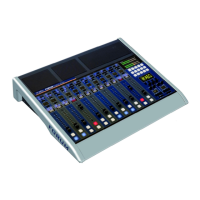AEQ FORUM
Digital audio mixer for broadcast applications
78
For Eagle and Phoenix Studio audio-codecs, the available options are:
• “Ring”: allows you to select the GPI where the incoming call signal provided by the
codec is wired. The key starts to blink when there is an incoming call. This function can
be combined in the same key with any of the following four functions.
• “Wait GPI”: selects and configures the physical GPI input associated to “WAIT”
function. The key turns on when WAIT mode (call on hold) is activated manually in the
audio-codec.
• “Wait GPO”: selects and configures the physical GPO output associated to “WAIT”
function. The key turns on when activated and puts the call on hold (WAIT mode).
• “On Air GPI”: selects and configures the physical GPI input associated to “ON AIR”
function. The key turns on when ON AIR mode (call on the air) is activated manually in
the audio-codec.
• “On Air GPO”: selects and configures the physical GPO output associated to “ON AIR”
function. The key turns on when activated and puts the call on the air (ON AIR mode).
• “Line”: for dual line codecs such as Eagle and Phoenix Studio, this identifies the
integrated line 1 and line 2, to assign the different GPIs and GPOs for remote control.
• “OK”: allows you to accept the created or edited configuration.
• “Cancel”: allows you to reject the created or edited configuration. No change you may
have made is saved.
IMPORTANT NOTE: The pairs of functions “Wait GPI”-“Wait GPO” and “On Air GPI”-“On Air
GPO” are exclusive between them (a programmable key can have only one of the two pairs
associated).
For Codecs it is usual to program at least two programmable keys per channel: one to share
“Ring”, “Wait GPI” and “Wait GPO” functions and another one to share “On Air GPI” and “On Air
GPO” functions. The following screens shows an example of programmable keys configuration
for remote control of an AEQ EAGLE audio-codec.

